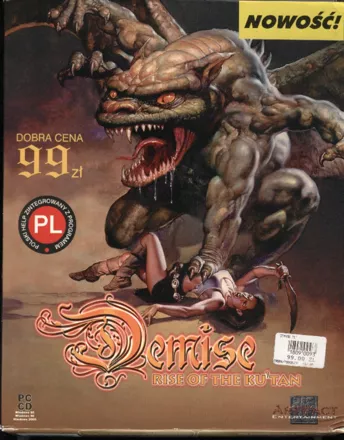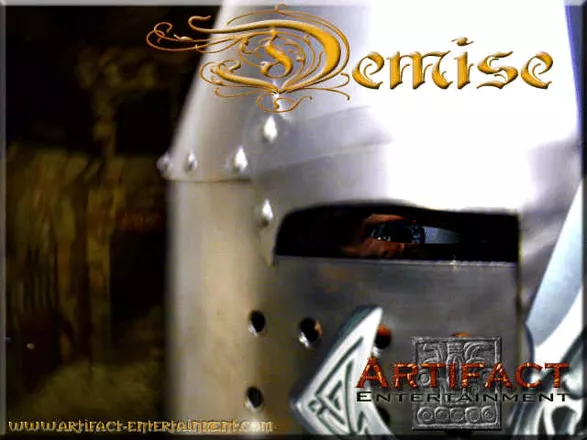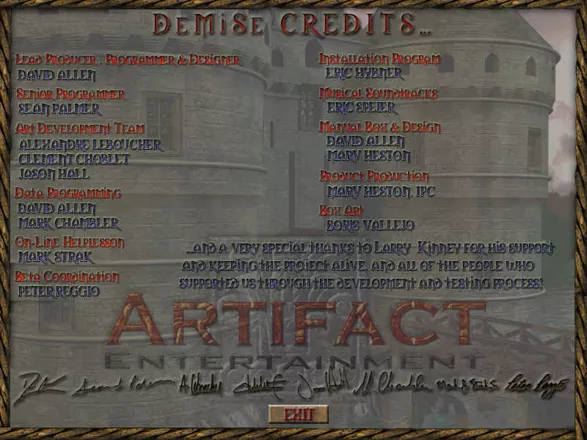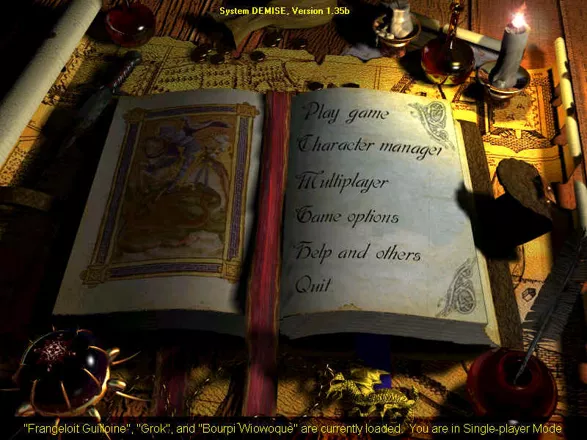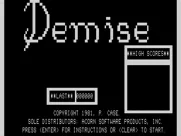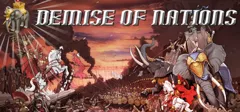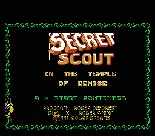Demise: Rise of the Ku'tan
Description official description
The mines of Dejanol were once the land's primary source of Mythinite, and a training grounds for adventurers until one day the town was overrun by demons in a surprise attack. They went as quickly as they came, the town was reclaimed by the guilds, and the mines were sealed. Now, the mines are reopened and Lord Gherrick has called for a hero (or band of heroes) to seek out and destroy the source of evil in its depths.
Demise is loosely based on Mordor, one of the various Rogue-likes, but updated into a first-person RPG with modern graphics, sound, music, and cooperative Internet multiplayer support.
You can create as many characters as you like, and join them into parties of one to four characters (in multi-player, you only play one character at a time, who can join with other players into a party). Characters are one of nine races (Human, Elf, Giant, Gnome, Dwarf, Ogre, Yeti, Saris, or Troll), and can belong to one or more of twelve guilds (Artisan, Warrior, Paladin, Ninja, Villain, Explorer, Thief, Barbarian, Magi, Sorcerer, Warlock, or Cleric). Different races have different natural resistances and starting stats, as well as different heights and better or worse eyesight, which actually affects the first-person display in the dungeon as you switch characters.
Each character can join as many guilds as you like (subject to stats, race, and alignment requirements) and access the skills of all at once, though in town you must choose only one guild in which to earn experience for each foray into the dungeon (which will also determine which class-restricted equipment you can wear).
As with most RPGs, advancement in the guilds requires earning experience. There is a penalty applied if you belong to multiple guilds which means you'll need more experience per level in each guild the more guilds you belong to. In addition, most guilds will occasionally assign you quests to kill a certain monster or find a certain item before they will consent to advance you another level. The maximum level in each guild is 999, so you can play for years before your character maxes out.
In addition to the guild quests, Lord Gherrick will assign you longer and more difficult quests, and there is a notice board for random single-player quests, and multi-player bounties or item requests.
To help you out on the quests, the town Seer can give you a rough idea where to find a particular monster or item, but she's not always right, and she charges fairly high prices.
Within the humongous 25-level dungeon, you'll find hundreds of different items and monsters. Unlike many Rogue-likes, the dungeon map is not random, which allows for the inclusion of lots of special areas. Your map is shared by all your characters.
Combat takes place in real-time, with your characters using your specified default actions. You can pause at any time to give new orders. Not all monsters are hostile; some will talk to you if you know their language, and others will offer to join you as companions and fight on your side (even if they're not great fighters, you can sell them to the Monster Confinement store in town). Of course, if you open their chest and take their stuff, peaceable monsters will become hostile.
As with most Rogue-likes, the only way to save is to exit the game, and your character is updated as you play. If you die, you can't just reload. You can be resurrected, but only in town, so you'll either have to have another character pay to hire rescuers to find and retrieve your corpse, or have another character or party-member find your corpse and carry it up to town. Demise does have the option to backup your saves in case your current game becomes corrupted, but this is intentionally a bit cumbersome so you won't be tempted to use it just to undo a bad event.
There is a demo version of Demise which allows you to explore all of the first five dungeon levels. The full version includes all 25 levels, as well as the Demise server if you want to host multi-player games.
Groups +
Screenshots
Credits (Windows version)
13 People (12 developers, 1 thanks)
| Senior Programmer | |
| Art Development Team | |
| Data Programming | |
| On-Line Helplesson | |
| Beta Coordination | |
| Installation Program | |
| Musical Soundtrack | |
| Manual Box & Design | |
| Product Production | |
| Box Art | |
| Special Thanks To | |
| Lead Producer, Programmer, and Designer |
Reviews
Critics
Average score: 60% (based on 9 ratings)
Players
Average score: 3.5 out of 5 (based on 7 ratings with 1 reviews)
The Good
This really is the sort of game you can get fanatically involved in, planning character development, arguing, angsting, and optimizing over choices. If you enjoy it, you will likely enjoy it for a very long time.
It also has some nostalgia appeal, because the visuals and mapping are extremely reminiscent of the early (pre-Bradley) Wizardries.
The Bad
Despite the area descriptions and special effects, the map is just obviously laid out in big movement squares with special flags, like an early Wizardry. Also like the early Wizardries, the graphics are serviceable but not great.
The Bottom Line
If you like planning and working for character and party development, if what you really enjoy about playing an RPG is crowing over the way you've built a dynamo of a party that can kick monster butt in areas no mere 100th-level wimp could survive, this is your game and you'll love it.
If you remember the original Wizardries, in all their wireframe glory, and wonder if somebody could use modern processing power to add lots of stuff to them without changing the basic format, this game is both your answer and something you'll likely enjoy playing enough to be worth buying it.
But if you want your RPG to be more immersive and avoid letting mechanics intrude on the experience of the world, you'll probably find this game repulsive. And if you demand really high-quality graphics and sound, you'll be sorely disappointed.
Windows · by weregamer (155) · 2003
Trivia
Development
Demise has an interesting history to its development cycle. The game originally started as Mordor II, published by vbdesigns (who created the original Mordor). After the plot had been finalised, the game was renamed Mordor 2: Darkness Awakening.
When the game began to look fairly polished, Interplay picked up the publishing license, and the game was re-titled Infinite Worlds. The Mordor 2 name was dropped due to copyright issues with the estate of JRR Tolkien. Mordor is the name of the dark lord Sauron's land within the world of Middle Earth that Tolkien created.
This didn't last very long, and David Allen took the license to a new company he founded, Artifact Entertainment. The Infinite Worlds title was dropped due to the name already being used by a hobby game developer for another rogue-like game. It was being developed by an individual called Chris La Mantia, and was apparently never released. (Archived project site)
Chris La Mantia on the matter:
Actually, I didn't slow them down on the title at all; their legal department C&D'ed me, but offered to register a new trademark for me as compensation. However, Interplay had the trademark application for "Infinite Worlds" and not vbdesigns, and when Interplay and vbdesigns parted ways (for reasons unknown to me), they offered the trademark for "Infinite Worlds" back to me. They never completed the paperwork, though, and the trademark died along with the game.
The game was completed at Artifact, and IPC Software received the rights to sell the game.
At some point in the development cycle of Artifact's next game, a major argument ensued and David Allen left the company to form a new one, Pharaoh Productions.
Legal proceedings followed between Pharaoh and Artifact over the rights to Demise. As of October 2002, the status of the game is still somewhat unknown, though Artifact are directing all Demise enquiries to Pharaoh.
Information also contributed by Chris La Mantia and deepcut
Analytics
Upgrade to MobyPro to view research rankings!
Related Sites +
-
Decklin's Domain
This is the official site for Demise: Rise of the Ku'Tan and its related games, including the official expansion Ascension due for release December 2008. -
The Unofficial "Demise: Rise of the Ku-Tan" Guide
Fan-created Guide with lots of detailed information and strategies on the game
Identifiers +
Contribute
Are you familiar with this game? Help document and preserve this entry in video game history! If your contribution is approved, you will earn points and be credited as a contributor.
Contributors to this Entry
Game added by andyhat.
Additional contributors: Brian Hirt, Nathan Jolly, Richard Whitwell, Patrick Bregger.
Game added July 26, 2000. Last modified April 5, 2024.
